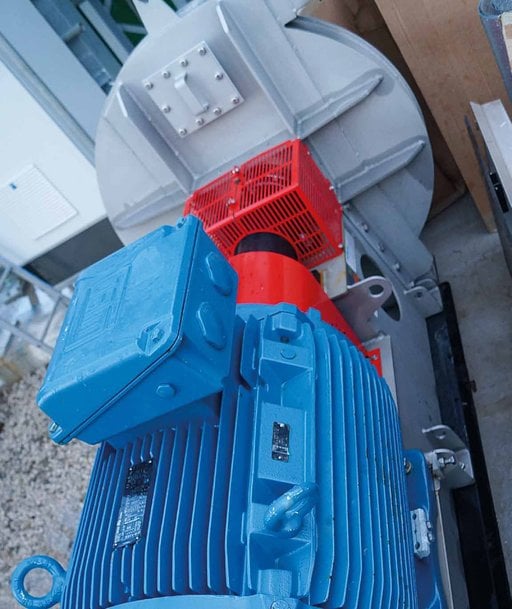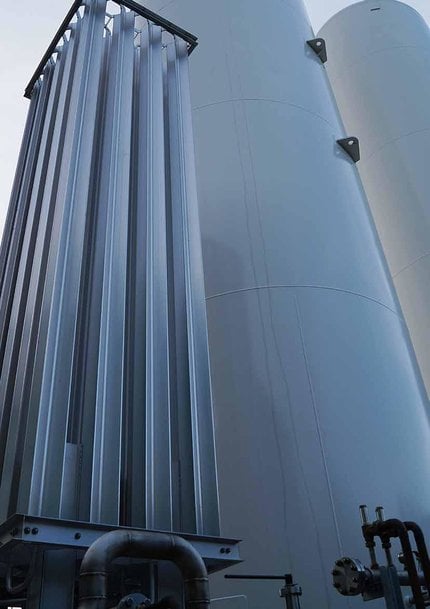www.industryemea.com
22
'22
Written on Modified on
Blowing hot and cold ~ LAES and the future of energy storage
With no geographical constraints, little environmental impact and no depletion on scarce materials, it’s no surprise that LAES have been cited as the future of energy storage. But, what does it take to get a LAES facility operational? Here, Marek Lukaszczyk, marketing manager for WEG Europe and Middle East explains.

Liquid Air Energy Storage (LAES) facilities provide a new way of storing electrical energy. Using large gas compressors to turn air into liquid, LAES provide a method of storing this pressurised energy for future use.
LAES, alongside other energy storage options, will prove to be critical as the world continues to transition to renewable power. Renewable sources, such as wind, solar and tidal — while they are far less damaging to the planet than fossil fuels — are notoriously difficult to predict. This fluctuation creates issues when balancing energy supply and demand.

Consider this as an example. A wind farm operating in the North of England may have several days of intense energy generation due to high wind speeds causing consistent movement of the plant’s turbines. However, if the United Kingdom’s wider energy grid is already saturated with power, there becomes a dilemma of where to store the wind farm’s excess energy.
As the world continues to transition to renewable power, the challenge of storing energy — and the ability to quickly release it when demand is high — is becoming a significant conversation in industry.
How do LAES work?
LAES facilities can provide a solution to fluctuating energy supply. Their large gas compressors turn air to a liquid and then store it in insulated, pressurised tanks, which keeps it as a liquid. In order to generate power, the air is then heated and allowed to expand again, and the pressure pushes a gas turbine around to generate power. Using this method, energy is stored, and the only emission created in this environment is air.
Air turns to liquid when refrigerated to -196°C, which is usually achieved by a cycle of compression, cooling and expansion, it can then be stored in conventionally insulated, ambient pressure vessels at very large scale. Exposure to ambient temperatures causes rapid re-gasification and a 700-fold expansion in volume, which is used to drive a turbine and create electricity.
Several years ago, WEG took part in a project designed by Highview Power Storage, to deliver the world’s first full scale LAES.
Making LAES operational
Highview Power Storage’s technology drew from established processes from the turbo-machinery, power generation and industrial gas sectors.
Stuart Nelmes Head of Engineering at Highview explained, “The beauty of this system is that each component part of the process is built using tried and tested technology, which we know works and has established performance parameters. The centrifugal fans sourced from Halifax Fan, one of the UK’s leading suppliers, driven by WEG motors, one of the worlds most recognised brands, therefore fitted our remit very closely.”

“The LAES system comprises of three primary processes: a charging system, an energy store and a power recovery stage,” Nelmes continued “The energy efficiency of each stage is crucial to the economic viability of the project. Because we have to power the system with the electricity we generate or buy it from the grid the energy efficiency of each component is very important.”
“Halifax has developed its centrifugal range to maximise energy efficiency and WEG offers a very energy efficient IE3 motor as standard so this also influenced our decision. Every little helps in this situation.”
The energy storage plant uses the same principle used to make your kitchen fridge cold — but more akin in scale to the effect you see freezing moisture in the air creating slabs of ice that crack off the surface of a space rocket as the fuel tanks empty. In the aforementioned project, Highview needed a very reliable, well-proven blown air solution to regulate the temperature and airflow around some of the key components in the system and so the Halifax Fan / WEG combination was a good option.
In addition, WEG’s after sales service and extensive support network could ensure that the technology would be reliable for years to come.
Green machines
A key benefit of LAES are their green credentials. Once constructed, the commercial installations will be close to environmentally neutral, as the output is simply air. Or in the case of this test unit, inert Nitrogen supplied by BOC, which makes up 78 per cent of the atmosphere.
LAES are very effective for storing energy from renewable sources such as wind turbines, solar panels and tidal pools. Particularly, when there is a grid surplus as it provides a method to store and then feed energy back into the grid when demand peaks.
These facilities have masses of potential for the future of energy storage. And as the world continues to aim towards ambitious emission reduction targets and renewable energy goals, energy storage will become a crucial mechanism of balancing energy supply and demand.
www.weg.net

